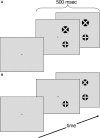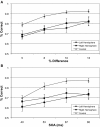Size Isn't All that Matters: Noticing Differences in Size and Temporal Order
- PMID: 20877428
- PMCID: PMC2944649
- DOI: 10.3389/fnhum.2010.00171
Size Isn't All that Matters: Noticing Differences in Size and Temporal Order
Abstract
The ability to represent time and size is essential for thought and action. These domains have traditionally been investigated independently. However, the processing of events in time and space is postulated to have considerable anatomical and behavioral overlap. Here we formally tested for associations and dissociations of abilities in these domains. We examined patterns of impairments in temporal order and relative size judgments in 40 patients with unilateral brain lesions and 20 age-matched control participants. While brain damage can impair both size and temporal order judgments (TOJ), we did not find evidence for global hemispheric differences. When patients were analyzed individually compared to control subjects, we found double dissociations in performances on both kinds of judgments. Voxel lesion symptom mapping allowed us to investigate shared and unique contributions of brain damage to deficits in judgments noticing differences in temporal order and in spatial extent. We found that size and temporal order estimations have overlapping cortical vulnerabilities within the left inferior frontal gyrus, left superior temporal cortex, and bilateral inferior parietal lobule. However, vulnerability unique to TOJ occurred with damage predominantly in left lateralized regions involving inferior and middle frontal cortex and inferior parietal lobule. Conversely, vulnerability unique to size judgments occurred with damage predominantly in right lateralized regions in the supramarginal gyrus and superior temporal cortex. These data provide evidence for interactions between the processing of spatial extent and temporal order; however, they do not provide evidence for right lateralized systems.
Keywords: inferior parietal lobule; size perception; temporal order judgment; temporal perception; voxel lesion symptom mapping.
Figures






Similar articles
-
Parietal versus temporal lobe components in spatial cognition: Setting the mid-point of a horizontal line.J Neuropsychol. 2009 Sep;3(Pt 2):201-11. doi: 10.1348/174866408X388197. Epub 2008 Dec 16. J Neuropsychol. 2009. PMID: 19338724
-
Neural correlates of audiovisual temporal processing--comparison of temporal order and simultaneity judgments.Neuroscience. 2015 Aug 6;300:432-47. doi: 10.1016/j.neuroscience.2015.05.011. Epub 2015 May 14. Neuroscience. 2015. PMID: 25982561
-
Left inferior parietal cortex integrates time and space during collision judgments.Neuroimage. 2003 Nov;20 Suppl 1:S82-8. doi: 10.1016/j.neuroimage.2003.09.025. Neuroimage. 2003. PMID: 14597300
-
Spatial neglect, Balint-Homes' and Gerstmann's syndrome, and other spatial disorders.CNS Spectr. 2007 Jul;12(7):527-36. doi: 10.1017/s1092852900021271. CNS Spectr. 2007. PMID: 17603404 Review.
-
Unilateral spatial neglect after posterior parietal damage.Handb Clin Neurol. 2018;151:287-312. doi: 10.1016/B978-0-444-63622-5.00014-0. Handb Clin Neurol. 2018. PMID: 29519463 Review.
Cited by
-
Human brain basis of musical rhythm perception: common and distinct neural substrates for meter, tempo, and pattern.Brain Sci. 2014 Jun 17;4(2):428-52. doi: 10.3390/brainsci4020428. Brain Sci. 2014. PMID: 24961770 Free PMC article.
-
Overlapping but Divergent Neural Correlates Underpinning Audiovisual Synchrony and Temporal Order Judgments.Front Hum Neurosci. 2018 Jul 3;12:274. doi: 10.3389/fnhum.2018.00274. eCollection 2018. Front Hum Neurosci. 2018. PMID: 30018545 Free PMC article.
References
-
- Bates E., Wilson S. M., Saygin A. P., Dick F., Sereno M. I., Knight R. T., Dronkers N. F. (2003). Voxel-based lesion-symptom mapping. Nat. Neurosci. 6, 448–450 - PubMed
LinkOut - more resources
Full Text Sources

